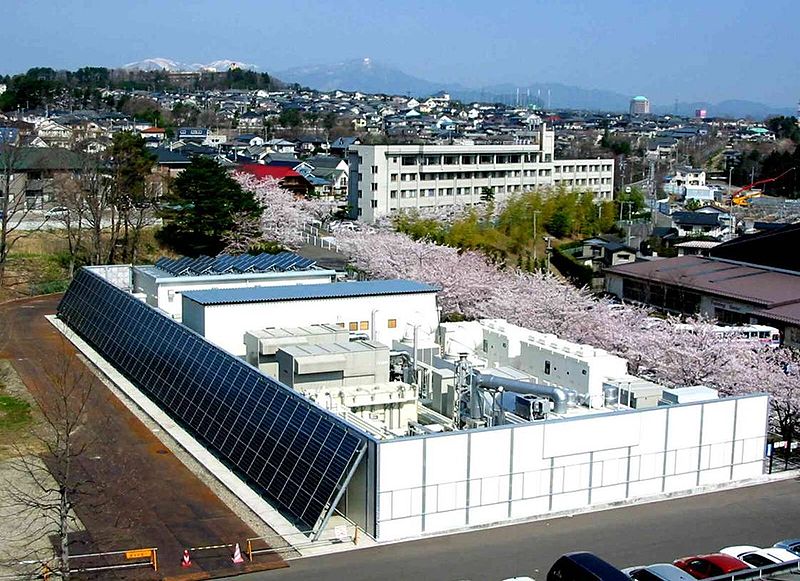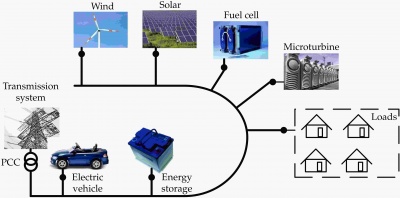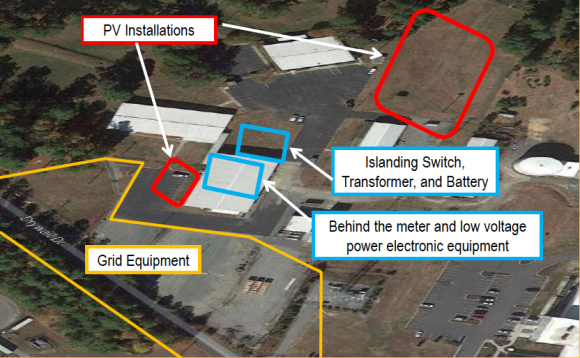On March 11, 2011, The Great East Japan Earthquake hit very hard and took out much of the electric power. However, there were pockets that managed to provide power and heat during the 2 – 3 days it took to restore the electric grid. One of such pockets was at Sendai City in the Tohoku district.

Sendai microgrid was initially designed in 2004 as a demonstration project. After the study was completed in 2008 the microgrid continued in operation. It is located on the campus of Tohoku Fukushi University. Normal load, including a hospital, is about 700 kW. The microgrid has two gas fired generators, each at 350 kW, a 200 kW fuel cell and a 50 kW PV array.
Similar situations were experienced during and after the Superstorm Sandy in 2012. While most of the electric system was out, there were sites where the lights stayed on. In most cases it was at single locations thanks to back-up generators, but there were also some larger systems like NY University on Manhattan and Co-Op City, a housing development in Bronx.
These events catapulted the interest in what is called microgrids. The idea of having a local electric system to disconnect and “islanding” itself in case the regular grid fails is very attractive. Industry experts/analysts projects microgrids soon to become a two digit billion dollar market.
Unfortunately, the high expectations have led many to opportunistically stretch the word microgrid to mean anything from a back-up diesel generator to “smart grid”. So let us take a closer look what it is or what it should be and which are the challenges and the opportunities.
There are many definitions, but the Microgrid Institute captures it well: “A microgrid is a small energy system capable of balancing captive supply and demand resources to maintain stable service within a defined boundary.” In other words it is an autonomous system, which has (distributed) generation sources, storage devices and controllable loads. CIGRE Working Group C6.22 adds to its definition that a microgrid can “operate connected to the main power network or islanded in a controlled, coordinated way.”
In most cases a microgrid is connected to a defined feeder in an electric substation. The load generally can range between 0.5 MW to 50 MW, but, as the Microgrid Institute points out microgrids are defined by their function, not their size.

Scematic representation of a microgrid. PCC refers to the point of common coupling to the main transmission system, the utility grid. Technische Universität Berlin.
There are several drivers for microgrids. The primary driver is reliability and resilience. The electric grid is hard to beat in terms of economy of scale and reliability. The larger the footprint of the grid the more sources and diversity of generation and the more routes to deliver the power to the load. The reliability is very high, expressed in popular terms it is in the three to five “9s” depending on location. Three “9s” is 99.9 %, which translates to 9 hours of outages per year. Four “9s” is 99.99 % equal to 1 hour of outages per year. Five “9s” is 99.999 % equal to 6 minutes of outages per year. Using “9s” this way may not give the whole picture. Especially large regional outages are very rare, but if and when they happen, the restoration can be in days rather than in minutes or hours.
For certain loads, e g large data centers, hospitals, financial institutions, military bases three to five “9s” may not be enough and/or the consequences of prolonged outages may be unacceptable. The solution has been and is to install back-up power generation, in most cases diesel generators. It can be done in many ways, from very simple/manual switching to very sophisticated seamless uninterruptible power systems (UPS).
Microgrids are taking the back-up power concept one step further. Connecting several loads with several sources of generation into an automnous system makes it capable to operate in an islanded mode for extended periods of time. With increased reliability concerns, in particular the risk of cyber-attacks, microgrids would strengthen the resilience.
Consequently, it is no coincidence that the military has become leaders in microgrids. They want their bases to always be mission ready regardless what happens with the “big grid”. During the September 2011 outage in San Diego the Navy could report all their bases in the area to be mission ready thanks to their own microgrids.
A second driver for microgrids can be summarized as reduced emissions. An intermittent renewable energy source such as photovoltaic (PV) cannot operate on its own unless it is coupled with a battery. Most PV systems are grid connected and when the grid goes down so does the power from the PV. Coupled with a battery a PV system can operate stand-alone, but there are practical limitations on the size of the battery. Also in areas with high penetration of PV even under normal situations there can be limits how much power a PV installation is allowed to feed into the system. A microgrid with other sources of generation or storage and multiple controllable loads can offer an opportunity to maximize the generation from the PV.
Going forward a third driver of microgrids may be economical benefits. With few exceptions it is not the case today. A microgrid generally cost more. The distributed power generation sources cost more than the large centralized power plants. The microgrid has to have a control system managing basically all the same issues (balancing load and generation, frequency and voltage control, etc.) Like the large grid but without its economy of scale. By the way designing the system controls for a microgrid is probably the biggest technical and economical challenge.
However, things are changing. The cost for new distributed generation tends to come down, while cost for new large centralized power plants tends to go up. Still a state-of-the-art natural gas fired combined cycle gas turbines (CCGT) plant is hard to beat on cost, but the delta is shrinking. PV systems are now at $4000 per kW, which are well below expected costs of the two new nuclear reactors under construction at Vogtle, SC, as well the most advanced coal gasification power plants at Edwardsport, IN, and Kemper, MS.
Already there is a very large amount of back-up diesel generators. Their only purpose so far is exactly that, back-up for outages. However, enabled by smart grid developments, if a back-up generator is part of a microgrid it could be used also in non-emergency situations. The only limitation could be, due to air quality constraints in non-attainment areas, that the diesel generator may be capped at 100 hours per year. Microturbines and fuel cells do not have that problem.

UC San Diego microgrid consists of two 13.5 MW gas turbines, one 3 MW steam turbine, and a 1.2 MW PV installation that together supply 85 % of the campus’ electricity needs, 95 % of its heating, and 95 % of its cooling. It has also a 2.8 MW molten carbon fuel cell. The campus is connected to San Diego Gas & Electric by a single 69 kV substation.
Probably the best economic opportunity are for sites like university campuses, where a heat and/or cooling load can be served by a combined heat and power (CHP) or combined cooling heat and power units (CCHP). It is the case at two of the most visible microgrids, the one at UC San Diego and the one at Princeton University. Having the CHP/CCHP as the primary generation sources gives an advantage, when designing a large microgrid. They are the base-load units and support the balancing of the system. They also enable additions of PV and other intermittent renewable energy sources.
What really can make microgrids a win-win will be how they interact with the grid. Designed right, i e with the capability to seamless disconnect and connect with the grid, microgrids can add value to the grid under normal conditions as well as providing resilience and helping speed up restoration after an outage.

Duke Energy announced in February 2015 that they are building a microgrid at its Mount Holly, NC, test lab. Duke Energy has formed a “Coalition of the Willing” with a focus on standardizing interoperable messaging protocols, which will enable integration of “smart devices” like inverters, control and communications equipment, etc. The coalition includes 25 partners including many of the most significant vendors in the industry.
Under normal conditions microgrids make the overall system control easier by providing a single point of interface instead of many points, several of them behind the meter. In regions with markets a microgrid will be an aggregator and interact with the wholesale markets, selling or buying power as well as ancillary services.
Restorations after major outages will reasonably be easier and faster with microgrids as building blocks than to have to do black-starts. The ultimate vision would be a self-healing grid. We may never get there, but microgrids are robust steps in this direction.
The three drivers – reliability & resilience, reduced emissions and economy – coming together may very well become a perfect storm in favor of microgrids.